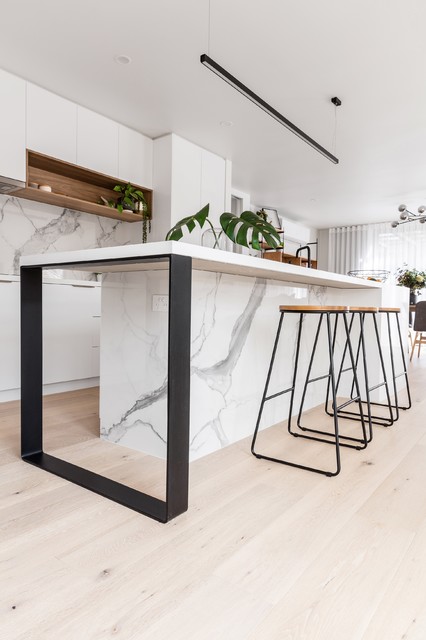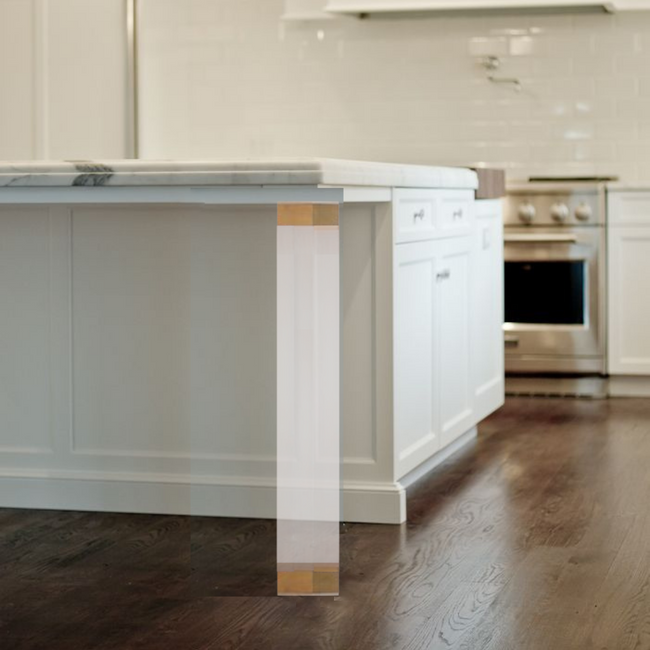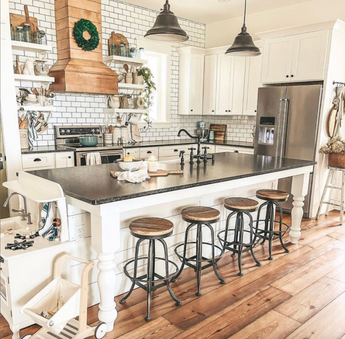Leading Considerations When Selecting a Kitchen Area Island Leg for Modern Kitchen Area Insides
In the realm of modern kitchen interiors, the option of a cooking area island leg is pivotal, affecting both appearances and performance. Key factors to consider consist of the choice of materials that integrate with contemporary style, as well as the leg's stability and support to make certain long-lasting efficiency. Additionally, elevation and percentages should be attentively examined to keep a natural look. As these elements link, they raise further inquiries concerning just how to attain the best equilibrium between style and practicality, leaving one to consider the ramifications of each decision on the overall cooking area experience.
Product Options
When it involves choosing a kitchen area island leg, material selections play an important function in both visual appeals and functionality. kitchen island leg. One of the most common materials include timber, steel, and composite options, each offering unique benefits and potential disadvantages
Wood is favored for its heat and classic charm, offering an ageless appearance that enhances numerous cooking area designs. It is extremely functional, allowing for personalization in regards to shades and finishes. Nonetheless, timber might need even more maintenance to avoid warping or damages from moisture.
Metal, on the other hand, brings a industrial and modern flair to kitchen area islands. Stainless-steel and wrought iron are preferred choices, recognized for their resilience and resistance to put on. They can hold up against the rigors of daily use yet may lack the warmth associated with wood.
Composite materials, such as engineered wood or synthetic blends, supply an equilibrium between rate, durability, and appearances. These choices are typically made to imitate the look of all-natural materials while offering resistance to spills and scrapes.
Inevitably, the option of material must line up with the overall kitchen design and intended usage, making certain that the kitchen area island leg is both functional and visually attractive.
Design And Style
The design and style of a cooking area island leg considerably add to the total visual of the room, enhancing the picked product. When selecting the leg design, think about the architectural style of the kitchen. For example, streamlined, minimal legs made from stainless-steel or acrylic harmonize with contemporary styles, while ornate, turned timber legs enhance typical or farmhouse aesthetics.
In addition, the finish of the leg can affect the aesthetic influence; a refined chrome or matte black surface might stimulate modern-day beauty, while troubled timber speaks with rustic appeal. The leg's form likewise plays an important duty-- right, angular kinds share an even more industrial feel, whereas tapered or curved legs introduce a softer, more inviting look.
Including ornamental aspects, such as makings or decorations, can add individuality and personality to the kitchen island, further boosting its duty as a prime focus. Eventually, the chosen leg design need to not only line up with the overall kitchen area layout but likewise mirror the home owner's personal preference, guaranteeing that the kitchen area island ends up being a functional and harmonious centerpiece within the modern-day kitchen interior.
Elevation and Proportions
Accomplishing the right height and proportions for a kitchen area island leg is essential for both performance and visual appeals. Kitchen islands generally vary in height from 28 to 36 inches, relying on their intended usage-- whether as a food preparation surface area, eating location, or office. Requirement kitchen counter height is roughly 36 inches, making it necessary that the legs you select enhance this height to give a smooth, integrated appearance.
Proportions additionally play an essential duty in the aesthetic balance of the cooking area. The size and weight of the leg should agree with the visit this website general layout of the island - kitchen island leg. A slender leg may be suitable for a minimalistic or modern island, while a more significant leg might be required for rustic or conventional styles. Furthermore, take into consideration the hop over to these guys spacing in between the legs; appropriate distance guarantees convenience and ease of motion around the island.
When picking the height and percentages of the cooking area island leg, maintain in mind the overall design theme of your kitchen area. This interest to detail not just improves the functionality of the space yet additionally contributes to a natural and aesthetically attractive interior decoration.
Security and Support
Continually making sure security and assistance in kitchen area island legs is crucial for both security and performance. A well-constructed cooking area island need to stand up to everyday use, including weight from devices, food prep work, and celebrations. As a result, the option of legs ought to focus on durable materials and designs that can supply adequate assistance.
When examining stability, think about the leg's material-- light weight aluminum, steel, or hardwood often offer superior strength contrasted to lighter choices. Furthermore, the design must feature a wide base to distribute weight uniformly and decrease the risk of tottering or tipping. For instance, legs created with an A-frame or cross-bracing can significantly boost stability.

Incorporating these considerations will certainly not only boost the general safety and security of the cooking area space however additionally boost the longevity and functionality of the cooking area island, making it a useful focal point in modern kitchen area interiors.
Completing Touches
When it pertains to finishing a cooking area island, thoughtful completing touches can dramatically improve both its visual charm and performance. Selecting the appropriate leg style is vital, but matching it with ideal information can change the whole area. Think about adding attractive aspects such as toe kicks or baseboards click reference that match the kitchen cabinetry or floor covering to develop a seamless look.

A cohesive shade palette and material selection will elevate the kitchen area island, making it an exciting focal point. By paying attention to these finishing touches, property owners can develop a cooking area island that is both practical and gorgeous, catering to their way of life and design preferences.
Final Thought

In the world of modern-day kitchen insides, the option of a kitchen area island leg is pivotal, affecting both visual appeals and performance.The style and design of a kitchen island leg significantly add to the overall aesthetic of the room, matching the picked product.Attaining the right elevation and proportions for a kitchen area island leg is critical for both capability and visual appeals.Constantly making sure stability and assistance in kitchen area island legs is important for both security and performance.In summary, selecting a kitchen area island leg for modern-day insides requires careful factor to consider of material choices, layout style, height, percentages, and security.